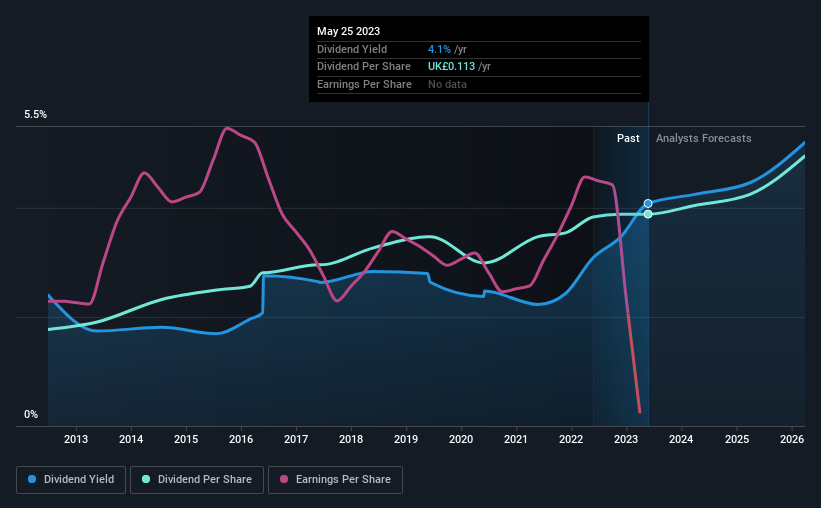- United Kingdom
- /
- Office REITs
- /
- LSE:HLCL
Helical (LON:HLCL) Is Paying Out A Larger Dividend Than Last Year

The board of Helical plc (LON:HLCL) has announced that the dividend on 28th of July will be increased to £0.087, which will be 5.5% higher than last year's payment of £0.0825 which covered the same period. Based on this payment, the dividend yield for the company will be 4.1%, which is fairly typical for the industry.
See our latest analysis for Helical
Helical's Distributions May Be Difficult To Sustain
We aren't too impressed by dividend yields unless they can be sustained over time. Before making this announcement, Helical was paying out quite a large proportion of both earnings and cash flow, with the dividend being 1,769% of cash flows. Paying out such a high proportion of cash flows can expose the business to needing to cut the dividend if the business runs into some challenges.
Recent, EPS has fallen by 2.7%, so this could continue over the next year. This will push the company into unprofitability, which means the managers will have to choose between suspending the dividend, or paying it out of cash reserves.

Helical Has A Solid Track Record
The company has a sustained record of paying dividends with very little fluctuation. The dividend has gone from an annual total of £0.0515 in 2013 to the most recent total annual payment of £0.113. This works out to be a compound annual growth rate (CAGR) of approximately 8.2% a year over that time. The dividend has been growing very nicely for a number of years, and has given its shareholders some nice income in their portfolios.
The Dividend's Growth Prospects Are Limited
Some investors will be chomping at the bit to buy some of the company's stock based on its dividend history. Let's not jump to conclusions as things might not be as good as they appear on the surface. Over the past five years, it looks as though Helical's EPS has declined at around 2.7% a year. If earnings continue declining, the company may have to make the difficult choice of reducing the dividend or even stopping it completely - the opposite of dividend growth.
Helical's Dividend Doesn't Look Sustainable
In summary, while it's always good to see the dividend being raised, we don't think Helical's payments are rock solid. In the past the payments have been stable, but we think the company is paying out too much for this to continue for the long term. We would probably look elsewhere for an income investment.
Companies possessing a stable dividend policy will likely enjoy greater investor interest than those suffering from a more inconsistent approach. However, there are other things to consider for investors when analysing stock performance. For instance, we've picked out 1 warning sign for Helical that investors should take into consideration. Looking for more high-yielding dividend ideas? Try our collection of strong dividend payers.
Valuation is complex, but we're here to simplify it.
Discover if Helical might be undervalued or overvalued with our detailed analysis, featuring fair value estimates, potential risks, dividends, insider trades, and its financial condition.
Access Free AnalysisHave feedback on this article? Concerned about the content? Get in touch with us directly. Alternatively, email editorial-team (at) simplywallst.com.
This article by Simply Wall St is general in nature. We provide commentary based on historical data and analyst forecasts only using an unbiased methodology and our articles are not intended to be financial advice. It does not constitute a recommendation to buy or sell any stock, and does not take account of your objectives, or your financial situation. We aim to bring you long-term focused analysis driven by fundamental data. Note that our analysis may not factor in the latest price-sensitive company announcements or qualitative material. Simply Wall St has no position in any stocks mentioned.
About LSE:HLCL
Helical
Engages in the development, investment, and rental of real estate properties in the United Kingdom.
Moderate growth potential with mediocre balance sheet.
Similar Companies
Market Insights
Community Narratives



